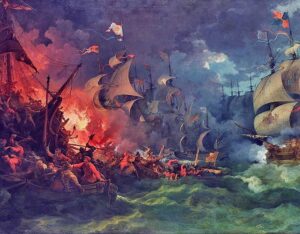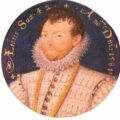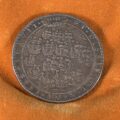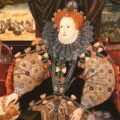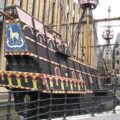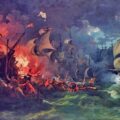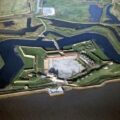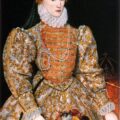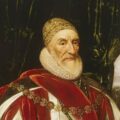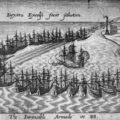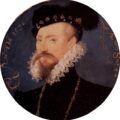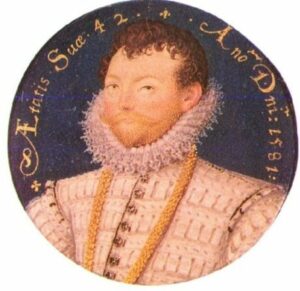
Here are some facts about Sir Francis Drake, the famous Elizabethan sailor and navigator:-
Birth: Sir Francis Drake was born around 1539-1544 in Tavistock, Devon. A miniature by Nicholas Hilliard painted in 1581 gives an age of 42 (therefore a birthdate of 1539) and another painting from 1594 was supposedly painted when he was 53 (therefore a birthdate of 1541).
Family: He was the eldest of twelve sons born to Edmund Drake, a Protestant farmer and minister, and his wife Mary Mylwaye. Drake was named after his godfather, Francis Russell, 2nd Earl of Bedford. Religious persecution after the Prayer Book Rebellion of 1549 led to the family relocating from Devon to Kent and it was there that Edmund Drake became a minister to the King’s army and then a vicar. Francis went to sea as an apprentice at the age of 13, joining the crew of a barque transporting merchandise to France. He inherited the barque from the owner at the age of 20 when the owner died.
Marriage: In 1569, Drake married his first wife, Mary Newman. She died in 1581 and in 1585 he married Elizabeth Sydenham, daughter of the Sheriff of Somerset. Drake did not have any children and after his death in 1596, his widow married Sir William Courtenay of Powderham.
Voyages: Drake made his first voyage to the New World at the age of around 23, with his second cousin Sir John Hawkins, whose family owned a fleet of ships based in Plymouth. Another voyage saw the fleet trapped by Spaniards in the Mexican port of San Juan de Ulua in 1568. Fortunately, the two men managed to escape but they lost all but two of their fleet. In 1570 and 1571 Drake undertook two trading voyages to the West Indes and then in 1572 he took two ships on a marauding campaign against the Caribbean’s Spanish ports. Drake was able to capture the port of Nombre de Dios and returned to England his ships laden with Spanish booty. In 1573 Drake attacked a mule train with the help of Guillaume Le Testu, the French buccaneer, capturing around 20 tons of gold and silver.
A Royal Commission – In 1577 Elizabeth I secretly commissioned Drake to lead an expedition to the American Pacific coast where there were Spanish colonies. Drake left Plymouth on the 15th November 1577 but only one of his fleet made it to the Pacific Ocean, his flagship “The Pelican”, which arrived there in October 1578. The ship was renamed “The Golden Hind” (after Sir Christopher Hatton’s coat of arms) and Drake became the first English sailor to navigate his way through the Straits of Magellan. The Golden Hind made its way north, along South America’s Pacific coast, plundering towns and Spanish ports as it went and capturing Spanish ships laden with gold, silver and jewels. In June 1579, Drake landed just north of Point Loma (present day San Diego, California), which was Spain’s northernmost holding in the Americas. He claimed it for England in the name of the Holy Trinity and called it Nova Albion, “New Britain”. He then turned south and made his way back home, arriving in England in September 1580. He was the first Englishman to circumnavigate the Globe.
Rewards: His achievements and his rich cargo of treasure and spices led to Elizabeth I knighting him on board his flagship on the 4th April 1581. Drake presented Elizabeth with a jewel to commemorate his successful circumnavigation. It was from Mexico and was made of enamelled gold decorated with an African diamond and a ship with an ebony hull. In return, Elizabeth presented Drake with a jewel and a portrait of herself.
Titles: Drake was knighted in 1581 and in the same year was made Mayor of Plymouth and a Member of Parliament. In 1584 he became a Member of Parliament again and his constituency was Bossiney.
Buckland Abbey: Drake bought Buckland Abbey near Yelverton, Devon, in 1580 and lived there until his final voyage.
Last Years: In 1585 Drake set sail for the West Indes and the Florida coastline where he did what came naturally to him, plundering. He captured the Spanish port of San Augustín and then returned home with some unsuccessful English colonists from Roanoke Island. His actions made Philip of Spain furious and war was imminent, but worse was to come for the Spanish king: in 1587, Drake sailed to Cadiz and Corunna, in Spain, where he destroyed 37 ships, ships that Spain were preparing to attack England with.
In 1588 Drake was Vice Admiral of the English fleet under Lord Howard of Effingham, the fleet which defeated the Spanish Armada. On 29th July 1588, Drake and Howard organised fire ships to send into the Spanish fleet at Calais to break their formation and to force them out to sea. The next day, Drake was present at the famous Battle of Gravelines.
In 1589 Sir Francis Drake and Sir John Norreys were given orders to 1) Seek out and destroy any remaining Spanish ships, 2) Help the rebels in Lisbon, Portugal and 3) Take the Azores for England. Unfortunately, 12,000 lives and 20 ships were lost off the Spanish coast.
Final Voyage: Drake’s final voyage to the West Indes and South America was a bit of a disaster. He failed to take the port of Las Palmas and also San Juan in Puerto Rico. He managed to survive a Spanish attack which saw a cannonball being shot through the cabin of his ship but he died of dysentery in 1596. As he lay dying, he asked to be dressed in his armour and after his death his crew put him in a lead coffin and buried him at sea just off the coast of Portobelo, Panama. His coffin has never been found.
The famous game of bowls: The story that everyone knows about Sir Francis Drake is the one of him playing a game of bowls on Plymouth Hoe when he is warned of the approach of the Armada. Allegedly, Drake commented that he had time to finish his game and defeat the Spanish fleet!
You can read more about The Spanish Armada in my series of articles starting with The Spanish Armada 1 – The Assembling of Troops at Tilbury Fort and including The Spanish Armada 4 – The Battle of Gravelines
